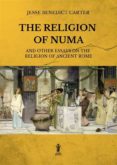THE RELIGION OF NUMA AND OTHER ESSAYS ON THE
THE RELIGION OF NUMA AND OTHER ESSAYS ON THE RELIGION OF ANCIENT ROME de JESSE BENEDICT CARTER
Ficha técnica
- THE RELIGION OF NUMA AND OTHER ESSAYS ON THE RELIGION OF ANCIENT ROME
- JESSE BENEDICT CARTER
- Idioma: INGLÉS
- Formatos: Pdf, ePub, MOBI, FB2
- ISBN: 9791255040996
- Editorial: EDIZIONI AURORA BOREALE
Libros en línea descarga pdf THE RELIGION OF NUMA AND OTHER ESSAYS ON THE RELIGION OF ANCIENT ROME in Spanish de JESSE BENEDICT CARTER
Overview
Rome forms no exception to the general rule that nations, like individuals, grow by contact with the outside world. In the middle of the five centuries of her republic came the Punic wars and the intimate association with Greece which made the last half of her history as a republic so different from the first half; and in the kingdom, which preceded the republic, there was a similar coming of foreign influence, which made the later kingdom with its semi-historical names of the Tarquins and Servius Tullius so different from the earlier kingdom with its altogether legendary Romulus, Numa, Tullus Hostilius and Ancus Marcius. We have thus four distinct phases in the history of Roman society, and a corresponding phase of religion in each period; and if we add to this that new social structure which came into being by the reforms of Augustus at the beginning of the empire, together with the religious changes which accompanied it, we shall have the five periods which these five essays try to describe: the period before the Tarquins, that is the “Religion of Numa”; the later kingdom, that is the “Reorganisation of Servius”; the first three centuries of the republic, that is the “Coming of the Sibyl”; the closing centuries of the republic, that is the “Decline of Faith”; and finally the early empire and the “Augustan Renaissance”.


0コメント